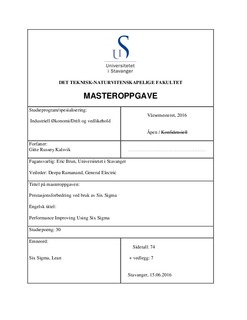Performance Improving Using Six Sigma
Master thesis
Permanent lenke
http://hdl.handle.net/11250/2412352Utgivelsesdato
2016-06-15Metadata
Vis full innførselSamlinger
- Studentoppgaver (TN-ISØP) [1454]
Sammendrag
Six Sigma and Lean are two of the most used improvement strategies in the world. In later years it has been argued that a combination of these will give an improved result compared to applying only one of the methods. The purpose of this thesis is to investigate the benefits and challenges of combining a Lean tool with a Six Sigma project. In order to study this in more detail a Six Sigma project was conducted using the steps of the DMAIC-model. The objective of the Six Sigma project was to reduce the cycle time in a maintenance process at a GE facility in Stavanger. During the project it was confirmed that some factors had an impact on the variation in the process and had to be addressed accordingly. These factors were either minimized or removed by utilizing the Fishbone from Six Sigma and the Value Stream Map from Lean. The result from applying these tools and the implemented measures that followed has resulted in a process that runs smoother and contains fewer defects. Another issue revealed was the way hours were being entered into SAP and a suggestion for how to improve this to make future work less time consuming is presented in the thesis. The result shows that the combination of these methods is feasible and has proven to be favorable for improving the maintenance process. The methods complement each other by focusing on different areas which in turn gives an overall improved result. More projects should however be conducted on different processes at different companies to check if such successful combination would repeat itself. Nevertheless, based on this thesis the combination is considered to be favorable.
Beskrivelse
Master's thesis in Industrial economics
